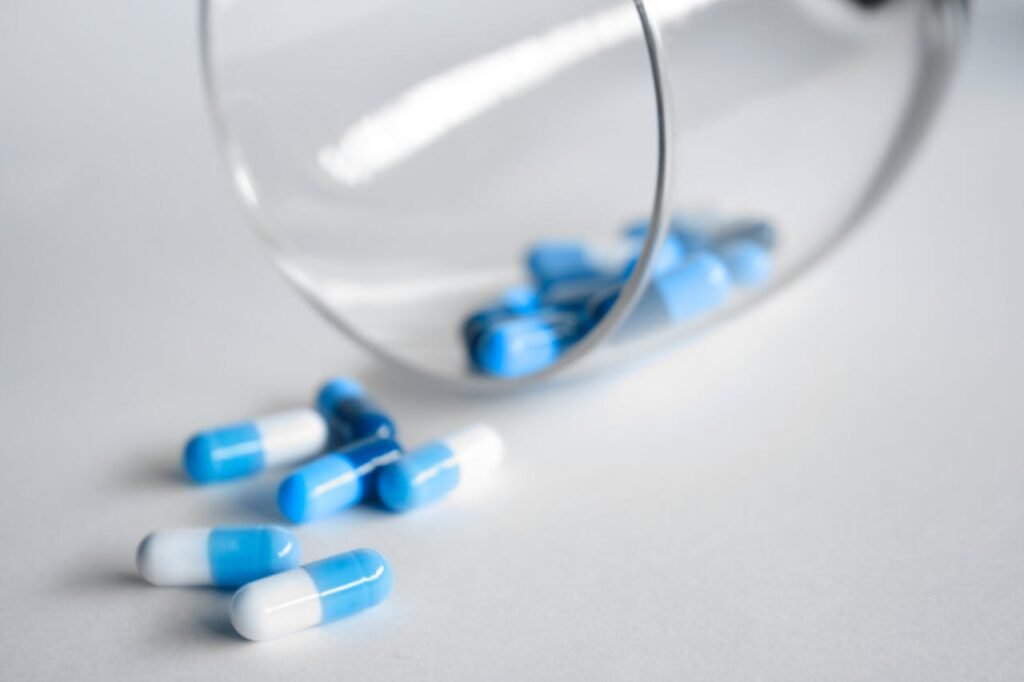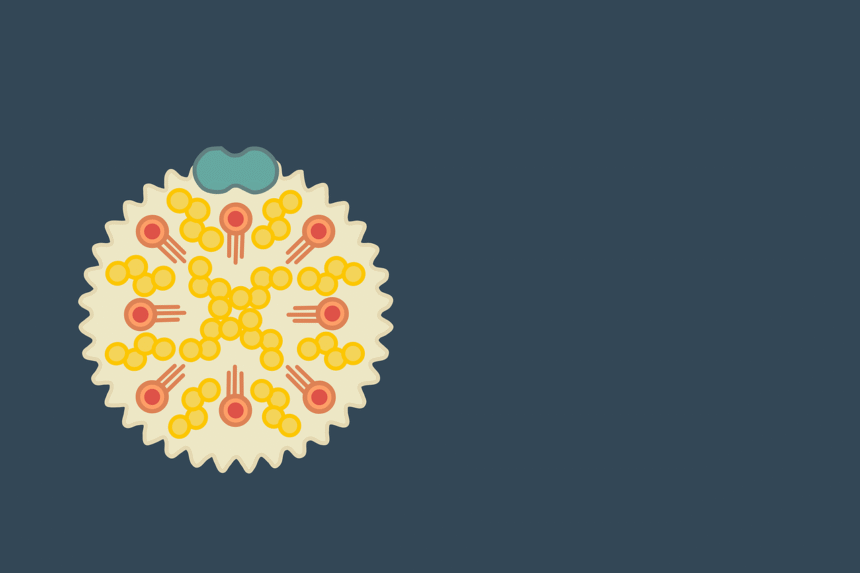High cholesterol affects approximately 60% of adults in England, making it one of the most common cardiovascular risk factors, according to Public Health England. Despite being largely preventable and treatable, high cholesterol contributes to over 7 million deaths globally each year from cardiovascular disease. The NHS emphasises that understanding and managing cholesterol levels is crucial for preventing heart attacks, strokes, and other cardiovascular complications.
Understanding Cholesterol: The Basics
Cholesterol is a waxy, fat-like substance found in every cell of the body. While often viewed negatively, cholesterol serves essential functions including cell membrane structure, hormone production, and bile acid synthesis. The British Heart Foundation explains that problems arise when cholesterol levels become imbalanced, particularly when harmful types accumulate in the bloodstream.
Types of Cholesterol:
Low-Density Lipoprotein (LDL) – “Bad” Cholesterol:
- Carries cholesterol from the liver to cells throughout the body
- Can build up in artery walls, forming plaques
- Higher levels increase cardiovascular disease risk
- Target level: Below 3.0 mmol/L for most people
- Target level: Below 1.8 mmol/L for high-risk individuals
High-Density Lipoprotein (HDL) – “Good” Cholesterol:
- Transports cholesterol from peripheral tissues back to the liver
- Helps remove excess cholesterol from artery walls
- Higher levels provide cardiovascular protection
- Target level: Above 1.0 mmol/L for men, above 1.2 mmol/L for women
Very Low-Density Lipoprotein (VLDL):
- Carries triglycerides and some cholesterol
- Can contribute to plaque formation
- Often included in LDL calculations
Total Cholesterol:
- Sum of all cholesterol types in the blood
- Target level: Below 5.0 mmol/L for most adults
- Less informative than individual cholesterol components
Triglycerides:
Though not cholesterol, triglycerides are often measured alongside cholesterol:
- Most common type of fat in the blood
- Elevated levels increase cardiovascular risk
- Target level: Below 1.7 mmol/L
- Often elevated alongside low HDL cholesterol
Causes and Risk Factors
High cholesterol results from complex interactions between genetic, dietary, and lifestyle factors. The European Society of Cardiology identifies multiple contributing factors:
Dietary Factors:
Saturated Fat:
The primary dietary influence on cholesterol levels:
- Found in red meat, full-fat dairy products, butter
- Palm oil, coconut oil (though effects are debated)
- Recommended limit: Less than 10% of daily calories
- Replacement with unsaturated fats more beneficial than simply reducing intake
Trans Fats:
Artificial fats with the most harmful effects on cholesterol:
- Increase LDL cholesterol while decreasing HDL cholesterol
- Found in some processed foods, baked goods, margarine
- UK has largely eliminated trans fats from food supply
- Check labels for “partially hydrogenated oils”
Dietary Cholesterol:
Has less impact on blood cholesterol than previously thought:
- Body produces most cholesterol endogenously
- Dietary cholesterol has modest effect on blood levels
- Found in animal products (eggs, shellfish, organ meats)
- Most people can consume moderate amounts without significant impact
Soluble Fibre:
Helps lower cholesterol levels:
- Binds cholesterol in the digestive system
- Found in oats, beans, fruits, vegetables
- Recommended intake: 25-35g daily total fibre
- Beta-glucan in oats particularly effective
Lifestyle Factors:
Physical Inactivity:
Sedentary lifestyle contributes to unfavourable cholesterol profile:
- Reduces HDL cholesterol levels
- May increase LDL cholesterol
- Regular exercise improves cholesterol ratios
- Even moderate activity provides benefits
Obesity:
Excess weight affects cholesterol metabolism:
- Associated with increased LDL and decreased HDL cholesterol
- Central obesity particularly problematic
- Weight loss improves cholesterol profile
- Even modest weight reduction beneficial
Smoking:
Tobacco use adversely affects cholesterol levels:
- Lowers HDL cholesterol
- Damages artery walls, making cholesterol deposition more likely
- Increases oxidation of LDL cholesterol
- Quitting smoking improves cholesterol profile
Medical Conditions:
Diabetes:
Poor glucose control affects cholesterol metabolism:
- Often associated with high triglycerides
- May lower HDL cholesterol
- Increases small, dense LDL particles (more atherogenic)
- Good glycaemic control improves lipid profile
Hypothyroidism:
Underactive thyroid affects cholesterol metabolism:
- Can significantly increase LDL cholesterol
- Often improves with thyroid hormone replacement
- Routine thyroid screening recommended in cholesterol evaluation
Kidney Disease:
Impairs cholesterol clearance and metabolism:
- Often associated with elevated cholesterol
- May require adjusted treatment targets
- Regular monitoring important
Liver Disease:
Liver produces most of the body’s cholesterol:
- Can affect cholesterol synthesis and clearance
- May require modified treatment approaches
- Regular liver function monitoring with statin therapy
Genetic Factors:
Familial Hypercholesterolaemia (FH):
Inherited condition affecting 1 in 250 people:
- Extremely high LDL cholesterol from birth
- Significantly increases cardiovascular disease risk
- Often requires medication regardless of lifestyle
- Family screening recommended
Polygenic Hypercholesterolaemia:
Multiple genetic variants contributing to elevated cholesterol:
- More common than FH
- Usually responds well to lifestyle modifications
- May require medication for optimal control
The HEART UK charity provides comprehensive information about genetic cholesterol disorders.

Health Consequences of High Cholesterol
High cholesterol, particularly elevated LDL cholesterol, is a major modifiable risk factor for cardiovascular disease. The World Health Organization identifies cholesterol management as crucial for preventing heart attacks and strokes.
Atherosclerosis Development:
Plaque Formation:
- LDL cholesterol infiltrates artery walls
- Oxidation of LDL triggers inflammatory response
- Macrophages consume oxidised LDL, becoming foam cells
- Smooth muscle cells proliferate, forming fibrous caps
- Plaques gradually narrow arteries
Plaque Rupture:
- Unstable plaques can rupture suddenly
- Triggers blood clot formation
- Can completely block artery blood flow
- Results in heart attack or stroke
Cardiovascular Complications:
Coronary Heart Disease:
- Leading cause of death in developed countries
- High cholesterol increases risk 2-3 fold
- Risk increases continuously with cholesterol levels
- Benefits of lowering cholesterol well-established
Stroke:
- High cholesterol increases ischaemic stroke risk
- Particularly important for carotid artery disease
- Cholesterol lowering reduces stroke risk by 15-20%
Peripheral Arterial Disease:
- Affects arteries supplying arms and legs
- Can cause pain, mobility limitations
- May progress to tissue death requiring amputation
- Cholesterol management crucial for prevention
Diagnosis and Monitoring
Cholesterol assessment requires laboratory testing, as high cholesterol typically causes no symptoms until complications develop. The NICE guidelines provide clear recommendations for cholesterol screening and monitoring.
Screening Recommendations:
General Population:
- Initial screening by age 40-75 (NHS Health Check programme)
- Earlier screening if cardiovascular risk factors present
- Repeat every 5 years if normal
- More frequent monitoring if abnormal or high risk
High-Risk Groups:
More frequent screening recommended for:
- Family history of premature cardiovascular disease
- Personal history of cardiovascular disease
- Diabetes mellitus
- Chronic kidney disease
- Rheumatoid arthritis or other inflammatory conditions
Laboratory Testing:
Fasting vs Non-Fasting:
- Fasting tests traditionally required (9-12 hours)
- Non-fasting tests increasingly accepted
- Total cholesterol and HDL unaffected by recent meals
- Triglycerides significantly affected by food intake
- LDL calculation may be less accurate non-fasting
Lipid Profile Components:
Standard testing includes:
- Total cholesterol
- LDL cholesterol (calculated or directly measured)
- HDL cholesterol
- Triglycerides
- Non-HDL cholesterol (total minus HDL)
Advanced Testing:
May be useful in certain situations:
- Apolipoprotein B: More accurate measure of atherogenic particles
- Lipoprotein(a): Independent cardiovascular risk factor
- LDL Particle Size: Small, dense LDL more atherogenic
- Coronary Calcium Score: Assesses existing atherosclerosis
Lifestyle Interventions for Cholesterol Management
Lifestyle modifications form the foundation of cholesterol management and can significantly improve lipid profiles. The British Dietetic Association emphasises that dietary changes can reduce LDL cholesterol by 10-25%.
Dietary Strategies:
The Portfolio Diet:
Evidence-based approach combining multiple cholesterol-lowering foods:
- Plant Sterols: 2g daily (found in fortified foods)
- Soluble Fibre: 10g daily (oats, beans, fruits)
- Nuts: 30g daily (almonds particularly effective)
- Soy Protein: 25g daily (tofu, soy milk, edamame)
- Can reduce LDL cholesterol by 20-30% when combined
Mediterranean Diet Pattern:
Comprehensive eating pattern with proven cardiovascular benefits:
- High in fruits, vegetables, whole grains, legumes
- Olive oil as primary fat source
- Regular fish consumption (especially oily fish)
- Moderate amounts of nuts and seeds
- Limited red meat and processed foods
- Moderate wine consumption with meals (optional)
Specific Cholesterol-Lowering Foods:
Oats and Barley:
- Beta-glucan fibre binds cholesterol in intestines
- 3g beta-glucan daily reduces LDL cholesterol by 5-10%
- Found in porridge, oat bran, pearl barley
- Most effective when consumed regularly
Nuts:
- Almonds, walnuts, pistachios most studied
- Provide healthy fats, fibre, plant sterols
- 30g daily (small handful) optimal amount
- Replace less healthy snacks rather than adding calories
Fatty Fish:
- Rich in omega-3 fatty acids
- Improves overall cardiovascular health
- May modestly raise HDL cholesterol
- Recommended 2-3 servings weekly
- Examples: salmon, mackerel, sardines, herring
Beans and Legumes:
- High in soluble fibre and plant protein
- Can replace higher saturated fat protein sources
- Include in meals several times weekly
- Examples: chickpeas, lentils, kidney beans, black beans
Physical Activity:
Regular exercise provides multiple benefits for cholesterol management:
Aerobic Exercise:
- Increases HDL cholesterol by 3-6%
- May modestly reduce LDL cholesterol
- Improves overall cardiovascular health
- Recommended: 150 minutes moderate intensity weekly
- Examples: brisk walking, swimming, cycling, dancing
Resistance Training:
- Complements aerobic exercise benefits
- Helps maintain muscle mass during weight loss
- May improve insulin sensitivity
- Recommended: 2-3 sessions weekly targeting major muscle groups
High-Intensity Interval Training (HIIT):
- May provide superior benefits compared to steady-state exercise
- Time-efficient approach for busy individuals
- Requires appropriate fitness level
- Should be progressed gradually
Weight Management:
Maintaining healthy body weight optimises cholesterol levels:
- Weight loss improves LDL/HDL ratio
- Even modest weight loss (5-10%) beneficial
- Focus on sustainable lifestyle changes
- Avoid extreme or fad diets
Healthy Weight Loss Strategies:
- Create modest caloric deficit (500-750 calories daily)
- Emphasise nutrient-dense, lower calorie foods
- Include adequate protein to preserve muscle mass
- Combine dietary changes with increased physical activity
- Seek professional support when needed

Medical Treatment Options
When lifestyle modifications alone are insufficient to achieve target cholesterol levels, medications provide effective additional treatment. The European Society of Cardiology provides evidence-based guidelines for cholesterol medication use.
Statin Medications:
Statins are the most extensively studied and effective cholesterol-lowering medications:
Mechanism of Action:
- Inhibit HMG-CoA reductase enzyme
- Reduce cholesterol synthesis in liver
- Increase LDL receptor expression
- Also provide anti-inflammatory effects
Available Statins:
- Atorvastatin: Most potent, longer-acting
- Simvastatin: Generic available, well-studied
- Rosuvastatin: Very potent, fewer drug interactions
- Pravastatin: Least likely to cause muscle problems
- Fluvastatin: Lower potency, fewer interactions
Benefits:
- Reduce LDL cholesterol by 30-50%
- Decrease cardiovascular events by 20-30%
- Proven mortality benefits in high-risk patients
- Generally well-tolerated
- Extensive safety data from decades of use
Side Effects:
Most people tolerate statins well, but potential side effects include:
- Muscle Pain: Occurs in 5-10% of users
- Liver Function Changes: Rare, usually reversible
- Diabetes Risk: Small increase in diabetes incidence
- Cognitive Effects: Controversial, not proven conclusively
Additional Cholesterol Medications:
Ezetimibe:
- Blocks cholesterol absorption in intestines
- Reduces LDL cholesterol by 18-25%
- Often combined with statins
- Well-tolerated with minimal side effects
- Useful for statin-intolerant patients
PCSK9 Inhibitors:
Injectable medications for high-risk patients:
- Evolocumab and Alirocumab available
- Reduce LDL cholesterol by 50-70%
- Very expensive, reserved for specific indications
- Administered by subcutaneous injection every 2-4 weeks
Bile Acid Sequestrants:
Older class of medications:
- Bind bile acids in intestines
- Force body to use cholesterol to make new bile acids
- Can cause gastrointestinal side effects
- May interfere with absorption of other medications
Fibrates:
Primarily used for high triglycerides:
- Reduce triglycerides by 30-50%
- Modestly increase HDL cholesterol
- May slightly increase LDL cholesterol
- Examples: fenofibrate, gemfibrozil
Combination Therapy:
For patients requiring additional cholesterol lowering:
- Statin plus ezetimibe most common combination
- Addresses multiple pathways of cholesterol metabolism
- Generally well-tolerated
- More convenient than separate medications
Special Populations and Considerations
Different patient groups require tailored approaches to cholesterol management:
Children and Adolescents:
Screening Recommendations:
- Universal screening age 9-11 and 17-21
- Earlier screening if high-risk family history
- Focus on lifestyle interventions
- Medication reserved for severe cases or familial hypercholesterolaemia
Family-Based Interventions:
- Involve entire family in healthy lifestyle changes
- Focus on positive habits rather than restrictions
- Emphasise fun physical activities
- Provide education about heart-healthy eating
Pregnancy:
Special Considerations:
- Cholesterol levels naturally rise during pregnancy
- Statins contraindicated during pregnancy and breastfeeding
- Focus on lifestyle interventions
- Resume medication after breastfeeding if needed
Older Adults:
Treatment Considerations:
- Benefits of statin therapy well-established even in older adults
- Consider overall health status and life expectancy
- May be more susceptible to muscle side effects
- Drug interactions more common due to multiple medications
- Regular monitoring important
Diabetes:
Intensive Management:
- Lower LDL targets recommended (below 1.8 mmol/L)
- Often require combination therapy
- Address multiple cardiovascular risk factors simultaneously
- Regular monitoring of lipids and glucose control
Monitoring Treatment Effectiveness
Regular monitoring ensures optimal cholesterol management and early detection of side effects:
Follow-Up Testing:
Initial Monitoring:
- Recheck lipids 6-8 weeks after starting medication
- Adjust dosage based on response and tolerance
- Liver function testing baseline and as clinically indicated
- Monitor for muscle symptoms
Long-Term Monitoring:
- Annual lipid profiles once stable
- More frequent monitoring if adjusting medications
- Regular assessment of cardiovascular risk factors
- Lifestyle counselling reinforcement
Treatment Targets:
Primary Prevention:
- LDL cholesterol below 3.0 mmol/L
- Consider below 1.8 mmol/L for high-risk individuals
- HDL cholesterol above 1.0 mmol/L (men), 1.2 mmol/L (women)
- Triglycerides below 1.7 mmol/L
Secondary Prevention:
- LDL cholesterol below 1.8 mmol/L
- Consider below 1.4 mmol/L for very high-risk patients
- Focus on maximum tolerated statin therapy
- Address all modifiable risk factors
Living with High Cholesterol
Managing high cholesterol is a lifelong commitment requiring sustained lifestyle changes and, often, medication adherence:
Practical Strategies:
Meal Planning:
- Plan heart-healthy meals in advance
- Batch cooking for convenience
- Reading nutrition labels effectively
- Finding healthy substitutes for favourite foods
Exercise Integration:
- Finding enjoyable physical activities
- Building activity into daily routines
- Overcoming barriers to exercise
- Setting realistic, progressive goals
Medication Adherence:
- Understanding the importance of consistent medication use
- Strategies for remembering daily medications
- Communicating with healthcare providers about side effects
- Cost-saving strategies for prescription medications
Support Resources:
Professional Support:
- Registered Dietitians: Personalised nutrition counselling
- Exercise Physiologists: Safe, effective activity programmes
- Pharmacists: Medication counselling and monitoring
- Lipid Specialists: Complex or refractory cases
Patient Organisations:
- HEART UK: 0345 769 7571
- British Heart Foundation: Comprehensive cardiovascular resources
- Diabetes UK: Support for patients with diabetes and high cholesterol
- NHS Choices: Reliable health information and local services
Technology Tools:
Mobile Applications:
- Cholesterol tracking and monitoring
- Heart-healthy recipe databases
- Exercise and activity tracking
- Medication reminder systems
Wearable Devices:
- Activity and exercise monitoring
- Heart rate tracking during physical activity
- Sleep quality assessment
- Integration with smartphone health apps
The Future of Cholesterol Management
Cholesterol treatment continues evolving with new medications and approaches:
Emerging Therapies:
Gene Therapy:
- Potential for long-lasting cholesterol reduction
- Early clinical trials showing promise
- May revolutionise treatment of genetic disorders
Novel Drug Targets:
- Additional pathways for cholesterol metabolism
- More personalised treatment approaches
- Combination therapies for optimal outcomes
Precision Medicine:
- Genetic testing to guide medication selection
- Personalised risk assessment tools
- Tailored lifestyle interventions based on individual factors
Conclusion
High cholesterol represents a major modifiable risk factor for cardiovascular disease, affecting millions of people worldwide. Through evidence-based lifestyle modifications including heart-healthy eating patterns, regular physical activity, and weight management, many individuals can significantly improve their cholesterol profiles.
For those requiring medication, statins and other cholesterol-lowering drugs provide safe, effective treatment options with proven benefits for preventing heart attacks, strokes, and cardiovascular deaths. The key to successful cholesterol management lies in combining appropriate medical treatment with sustained lifestyle changes and regular monitoring.
Resources from organisations like HEART UK, the British Heart Foundation, and the NHS provide valuable information and support for individuals managing high cholesterol.
Remember that cholesterol management is a long-term commitment that pays significant dividends in terms of cardiovascular health and overall wellbeing. With appropriate treatment and lifestyle modifications, most people with high cholesterol can achieve target levels and dramatically reduce their risk of heart disease and stroke.






